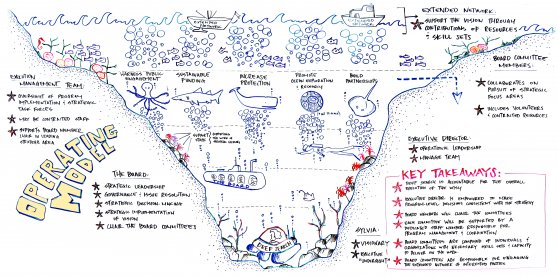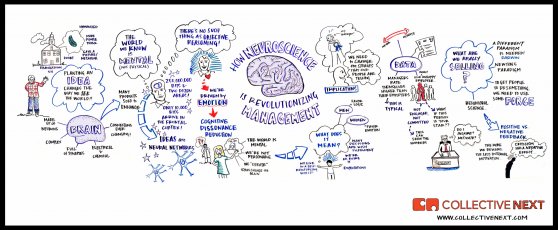Graphic facilitation has arrived! The Wall Street Journal recently published an article by Rachel Silverman extolling the benefits of graphic facilitation. Silverman also appeared on The News Hub to share her research into the groundswell of organizations currently improving their level of collaboration through the use of scribes. Yet, Silverman’s explanation of what she refers to as “visual note-taking” is just scratching the surface of the significant purpose, science, or organizational benefits of graphic facilitation.
Our years of experience helping organizations achieve effective collaboration have taught us at Collective Next, LLC that there is much more to graphic facilitation than just “doodling”. Graphic facilitation is one of the methods of creativity that businesses are encouraging throughout their organizations to drive innovation and excellence through effective collaboration. Graphic facilitators, or scribes, synthesize conversations in real-time and graphically represent the flow of ideas, creating a “collective memory” which allows people to more easily absorb ideas, follow the flow of the group’s thoughts, reference past ideas, and be fully engaged in the process. Thus, graphic facilitation can increase engagement, communication, and the understanding of ideas.
An example of a 45 minute scribed conversation.
 An example of a scribed advisory board off-site.
An example of a scribed advisory board off-site.
According to Plato, when someone says the word “chair”, a picture of a chair pops into your head that you use as a reference to understand what the person is talking about. The picture you see may be different than others, for example you may see a recliner whereas someone else may see director’s chair. Yet, everyone’s picture of a chair will include the same essential elements of a chair, legs, a seat, etc. This is why a picture is worth a thousand words. Graphics allow us to cut past the need for descriptive words and allow you to personalize your own understanding of an idea without getting caught up in someone else’s description of it. It is hard to represent ideas in a way that eliminates the clutter of interpretation, and that is part of what scribes are able to do. Thus, when we work with organizations, graphic facilitation expedites the collaborative process by removing the need for extraneous words and personalizes the process, increasing shared understanding and engagement.
For example, the illustration above scribed by John Colaruotolo of Collective Next, LLC effectively communicates what is described in this post and more in much less time and more succinctly.
When graphic facilitation is integrated with expert design and facilitation, the process of effective collaboration can be fully realized, unlocking organizations potential to achieve sustained excellence.
Be on the look out for more scribed posts on graphic facilitation!
To learn more about graphic facilitation click here. To learn more about how Collective Next, LLC can help you leverage graphic facilitation, expert design and facilitation to help organizations improve business performance click here.
Back






